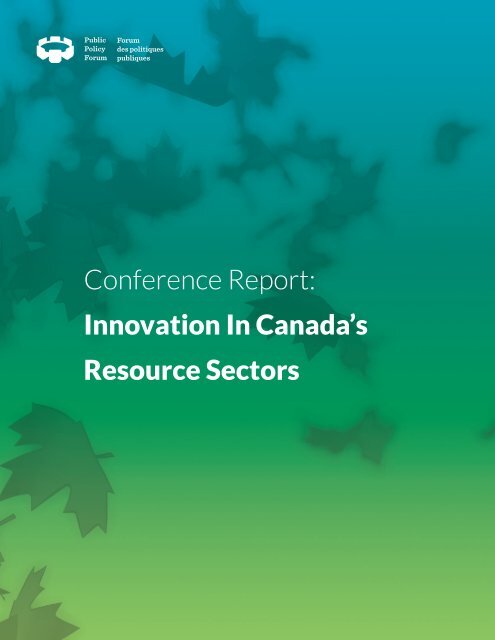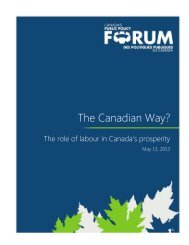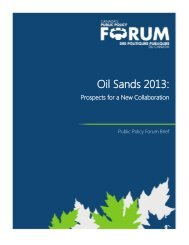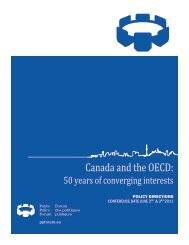Conference Report: Innovation In Canada's Resource Sectors ...
Conference Report: Innovation In Canada's Resource Sectors ...
Conference Report: Innovation In Canada's Resource Sectors ...
- No tags were found...
Create successful ePaper yourself
Turn your PDF publications into a flip-book with our unique Google optimized e-Paper software.
<strong>Conference</strong> <strong>Report</strong>:<strong><strong>In</strong>novation</strong> <strong>In</strong> Canada’s<strong>Resource</strong> <strong>Sectors</strong>
Public Policy ForumBuilding Better GovernmentThe Public Policy Forum is an independent, not-for-profitorganization dedicated to improving the quality of governmentin Canada through enhanced dialogue among the public, privateand voluntary sectors. The Forum’s members, drawn frombusiness, federal, provincial and territorial governments, thevoluntary sector and organized labour, share a belief that anefficient and effective public service is important in ensuringCanada’s competitiveness abroad and quality of life at home.Established in 1987, the Forum has earned a reputation as atrusted, non- partisan facilitator, capable of bringing together awide range of stake- holders in productive dialogue. Its researchprogram provides a neutral base to inform collective decisionmaking. By promoting information- sharing and greater linksbetween governments and other sectors, the Forum helps ensurepublic policy in our country is dynamic, coordinatedand responsive to future challenges and opportunities.© 2010, Public Policy Forum1405-130 Albert St.Ottawa, ON K1P 5G4Tel: 613.238.7160Fax: 613-238-7990www.ppforum.ca978-1-927009-04-8Ce document est disponible en français: www.forumpp.caDesigned by ICTINUS
Contents5.8.12.13.15.18.21.<strong>In</strong>troductionKey ThemesMoving FowardConclusionParticipant List<strong><strong>In</strong>novation</strong> <strong>In</strong> The <strong>Resource</strong> SectorThank You To Our Partners3
Elizabeth Cannon, University of Calgaryand Glen Schmidt, Laricina Energy
<strong>In</strong>troduction<strong>In</strong> recent years, innovation has been at the forefrontof discussions on the future of the Canadian economy.Concerns about economic competitiveness and ourrelatively low position in international rankings ofinnovation and productivity have caused many todecry the innovation gap in Canada. As a result,heavy emphasis has been placed on transforming theCanadian economy into a leader in innovation andknowledge generation.While this new vision of Canada is exciting, a seriousquestion stands out: can a country with a rich resourcebase balance innovation and knowledge-based activitieswith an economy underpinned by the extraction andexport of commodities? Must we downplay our resourcebase in favour of developing a competitive advantagein knowledge and innovation?Many have answered that question in the affirmative,suggesting that continued emphasis on the resourcesector will in the long-term make Canada a laggard ineconomic growth. Within this, there has been a strongsuggestion that the resource sectors have little capacityfor innovation, and that the continued export of resourcesnegatively impacts the competiveness of other sectors.This has resulted in the recommendation that Canadiangovernments and companies make a concerted effort tooffset the commodity emphasis that has guided muchof our economic policy in favour of one based oninnovation and knowledge generation. However,this denies the serious potential that exists to exploreinnovative new ways to continue the growth in resourceproductivity and sustainability.Canada’s energy, forestry and mining sectors represent11% or $131B of Canadian GDP and contribute over750,000 jobs to the Canadian economy. The resourcesectors are also a significant part of Canada’s tradeportfolio, accounting for nearly half of all Canadiangoods exported in 2009. The economic importanceof these resources to Canada is obvious. What needsto be addressed is how we can develop a strategy toensure that these resources not only continue to generatethe large amounts of wealth that we have seen, but alsothat this is done so in a manner that ensures a resilientand sustainable future, and from all standpoints:economic, environmental, and social.To date, there has been a relative absence of attention onthe role that innovation has played in Canada’s resourcesectors. It is clear that advancing a culture and practiceof innovation in Canada’s resource sectors is vital toensuring positive contributions to the economy and theoverall well-being of Canada. To achieve this , leadersfrom the Canadian mining, forestry, oil and gas andenergy sectors from across Canada must come togetherto help formulate an understanding of the ways in whichinnovation can be made an essential component of ourresource industries.5
Peter Josty, the Centre for <strong><strong>In</strong>novation</strong> Studies (THECIS);Annette Trimbee, Advanced <strong><strong>In</strong>novation</strong>and Education, Government of Alberta;Stephen Lucas, Natural <strong>Resource</strong>s Canada;Dave Collyer, Canadian Associationof Petroleum Producers
OverviewOn October 22, 2010, the Public Policy Forumconvened a one-day conference in partnership withNatural <strong>Resource</strong>s Canada: <strong><strong>In</strong>novation</strong> in Canada’s<strong>Resource</strong> <strong>Sectors</strong>. The purpose of the conference wasto uncover the current state of innovation in the resourcesectors, as well as to discuss opportunities and strategiesfor advancing innovation.The conference was chaired by University of CalgaryPresident Dr. Elizabeth Cannon. The panelists includedmembers of the private, academic, and federal andprovincial public sectors, representing a variety ofdifferent resource sectors. Three panels were convened:“Drivers of and Barriers to <strong><strong>In</strong>novation</strong>”; “Research andKnowledge Generation in the <strong>Resource</strong> <strong>Sectors</strong>; and“The Future of <strong><strong>In</strong>novation</strong> in Canada’s <strong>Resource</strong><strong>Sectors</strong>.” A luncheon keynote was provided by AvrimLazar, President and CEO of the Forest ProductsAssociation of Canada on the subject of innovation inpublic engagement. A summary discussion at the closeof the conference was delivered by Dr. Cannon andGlen Schmidt, CEO of Laricina Energy.Participants and panelists were asked to reflect on thecurrent understanding of innovation in our resourceindustries. A short paper was prepared in advance ofthe conference by Natural <strong>Resource</strong>s Canada thatcaptured the economic importance of these industries,their innovation performance, and provided an overviewof the relationship between innovation and productivityin Canada’s resource sectors.Assessing the UrgencyThere are a number of imperatives driving the needfor innovation in Canada’s resource sectors. First andforemost is the business case for innovation – thatour industries should continuously be striving for newand better ways to improve their business. <strong><strong>In</strong>novation</strong>is readily identifiable across the resource sectors;indeed, innovations such as the development of SteamAssisted Gravity Drainage (SAGD) technology in theoil sands have propelled the sector forward. However,there are a number of new imperatives driving theneed for innovation.The first such challenge is found in the characteristicsof the resources themselves, many of which are stillbeing discovered. While the Canadian landscape isblessed with an abundant resource base, many of theseresources are increasingly unconventional, making themmore difficult to extract and more costly to produce.This also means that relative to other producers, Canadiancompanies often find themselves on the hard part of thecost curve. Relatively more expensive resources thusmake competing at a global level more challenging forCanadian companies.Secondly, the need for more value-added activity inCanada is an issue that is recognized by many as aserious issue for the resource sectors. Researchers andcompanies must continue to seek ways to process andupgrade materials in a cost-efficient manner in Canada,thus creating more jobs and increasing the value ofeconomic activity.7“<strong>In</strong> the words of one panelist, the need to“act urgently, but be patient” is a centralmessage that must reverberate throughboth the industry and the public.”Finally, in order to maintain the social license necessaryto continue operating, resource industries must do abetter job of communicating with Canadians, improvingperformance, maximizing social benefits and ensuringthat the environmental impacts of these activities areof minimal consequence. <strong>In</strong>creasing public attention tothe environmental impacts of resource extraction requiresmore effective communication as companies operatingwithin the sector intensify their efforts to offset theenvironmental impacts of extraction. <strong>In</strong> the words of onepanelist, the need to, “act urgently, but be patient” is acentral message that must reverberate through both theindustry and the public.
<strong>Conference</strong> <strong>Report</strong>: <strong><strong>In</strong>novation</strong> <strong>In</strong> Canada’s <strong>Resource</strong> <strong>Sectors</strong>Key Themes8Measuring <strong><strong>In</strong>novation</strong><strong>In</strong> order to understand the unique characteristics ofinnovation in the resource sector, we must broadlydefine it as more than invention – innovation includesnew processes, new organizational structures, and newoperating methods. As Cooper Langford, Director ofthe Science, Technology and Society Program at theUniversity of Calgary, defines it, innovation is“bringing novelty into productive use.” 1While this is commonly understood across sectors,relevant metrics need to be established. The narrowapplicability of tax benefits such as the ScientificResearch and Experimental Development (SR&ED)credits, which have become a common reference tomeasure innovation in Canada, points to the exclusionof many innovative activities from being captured.Further, while typically applied metrics of innovation,such as R&D effort, educational attainment of theworkforce, and intellectual property in the formof patents, copyrights and trademarks, are usefulmeasurements, they do not fully capture the fullsuite of innovation occurring in the resource sector.Many of the innovations in resource industries have comeabout as a result of a “tweaking in the field” model ratherthan through research generated in labs and universities.As a result, typical indicators of innovation do not tell thewhole story. Furthermore, innovation is often outsourcedthrough service, supply and technology enterprises ona discrete basis. An effort to truly capture all resourcesector innovation by using traditional metrics as well asthrough defining new and more relevant metrics such asexploration technology or process improvements needsto be considered.Creating a Culture of <strong><strong>In</strong>novation</strong><strong>In</strong> order to advance innovation, our resource industriesmust strive to build a culture of innovation thatpermeates across different sectors and in the multitudeof organizations involved. Linking resource companies,research institutions and governments through ashared commitment to innovation (via collaboration,connectivity, and best practices) is critical to buildingan environment that recognizes, promotes and rewardsinnovation. The importance of taking an ecosystemapproach to innovation has been demonstrated in manyother sectors. The Canadian Mining <strong><strong>In</strong>novation</strong> Council(CMIC), which is dedicated to research, commercializationand innovation, is an example of the type ofnetwork that needs to be established across the resourcesector. For example, the CMIC brings together industry,government and academics to work collectively tostrengthen the mining sector.One panelist at the conference provided a brief storyabout a plant he had visited which had tripled its output.The reason for this dramatic increase in output wasunknown to even the plant managers, until eventuallyit was revealed that two of the plant’s process engineershad spent the last few years making small tweaks tovarious processes and production tools, which hadhad the cumulative effect of radically improving theplant’s productivity. This example leads to some simplequestions about the ways in which corporate culturecan encourage innovation. Does the culture allow foremployees to innovate? Are employees given the trustand freedom to suggest and implement change?It’s also important to consider what the overarchingcorporate strategy is, and what role innovation can playwithin that strategy.1Cooper H. Langford “Outcomes of University Research in Canada: <strong><strong>In</strong>novation</strong> Policyand <strong>In</strong>dicators of Triple Helix Relationships” The Centre for <strong><strong>In</strong>novation</strong> Studies
People<strong><strong>In</strong>novation</strong> is driven by people, and it’s clear thatresource industries have been able to attract exceptionalindividuals who work hard to make sure these businessesthrive. A continued emphasis needs to be placed notonly on attracting the best and the brightest, but alsoon letting people know that a career in the resourcesector is one in which they will have the ability to pursuecreative new ideas. Employees must be entrusted withopportunities and capacity to effect change, whetherthat be incremental or radical.<strong>In</strong> addition, there is a broad community that resourceindustries can draw from to improve their capacity forresearch and innovation. For example, graduate students,employed through co-operative education programs,internships, and scholarships can contribute significantly.Similarly, there is a growing strength found in theincreasing number of new Canadians and foreign studentswho come to study in Canadian universities, who in somecases come from countries with strong resource industriesof their own. Finding ways to engage these new andemerging leaders, who often possess significant skillsand a creative outlook, offers an important opportunityfor advancing innovation. <strong>In</strong>deed, many organizationsrepresented at the conference acknowledged theimportance of this type of engagement, even in engagingstudents in the K-12 education system to promote thevalue of science and technology.Leaders and ChampionsIf innovation is about people, a commitment toinnovation must be demonstrated at the top.Strong leaders and champions who are committedto innovation, and to recognizing and rewarding itamong all levels of an organization, form the foundationfor success. Leaders must demonstrate that there is ashared commitment to innovation.<strong>In</strong> addition to motivating and encouraging staff,leaders who champion innovation are needed to ensurethat goals and objectives are clearly defined and includedin corporate strategy. This could be in the form of anannual evaluation of innovation, a strategic plan, or anemployee recognition program that highlights exceptionalcontributions from employees. Further, includinginnovation in leadership training courses offers theopportunity to develop the capacity of new leaders tobalance innovation and risk.9
<strong>Conference</strong> <strong>Report</strong>: <strong><strong>In</strong>novation</strong> <strong>In</strong> Canada’s <strong>Resource</strong> <strong>Sectors</strong>10Enhancing Connectivity andCollaborationJust as a culture of innovation across sectors needs to beestablished, enhancing connectivity and collaborationwithin specific industries needs to be a core goal of anydiscussion around innovation. Firms within industriesneed to consider how they can work together, whetherthrough sharing best practices, collaborating on projects,or finding other unique arrangements to tackle commonproblems. They must also reach out to other sectors,to ensure that the needs of resource industries areadequately understood and met. Such efforts will includereaching out to financial analysts, regulators, and otherkey influencers who can play roles in advancing resourcesector innovation. Connectivity must be increased acrosssectors, and across geographic locations.Enhanced collaboration, of course, needs to start withinthe resource industries, especially where competitivepressures sometimes create barriers. For example,FP<strong><strong>In</strong>novation</strong>s, the world’s largest private, not-for-profitforest product research organization, brings togetherinternationally recognized research teams to shareknowledge and act on a united basis. Strengthenedengagement, integrated operations, and more efficientknowledge generation and transfer are some of thebenefits that have emerged from such collaboration.Some businesses could begin by looking atopportunities in the areas of safety, environmentaland social performance, where collaboration has notalways presented challenges on the same scale aseconomic competitiveness. However, connections withgovernments, research organizations and universitiesto find best practices and develop new products andprocesses based on shared knowledge should alsobe explored. Such an approach would also offer thebenefit of sharing risk with multiple partners, forexample through co-funding demonstration projects andtesting new technologies. Finally, in order to promoteconnectivity among resource industries and the broadercommunity, there is a need for multi-sectoral translators,interpreters and communicators. These are individualsand organizations who can help explain complextechnical issues as well as policy and regulatory needs,to connect governments, private sector organizations andresearch institutions.“Strengthened engagement, integratedoperations, and more efficient knowledgegeneration and transfer are some of thebenefits of collaboration.”
Vicky Sharpe, Sustainable DevelopmentTechnology Canada;Judy Fairburn, Cenovus;Danial Wayner, National Research Council of Canada;David Lynch, University of Alberta
<strong>Conference</strong> <strong>Report</strong>: <strong><strong>In</strong>novation</strong> <strong>In</strong> Canada’s <strong>Resource</strong> <strong>Sectors</strong>1. Define and measure innovationbased on relevant metricsAs stressed in this report, innovation comes in manyshapes and sizes. As such, innovative activities havenot always been captured by traditional measures.A concerted effort must be made to fully accountfor the innovative activities that are actually takingplace in Canada’s resource industries. Developinga more fulsome picture of the sector, dispellingmyths surrounding the supposedly staid nature ofthese industries, and honing in on the challengesand opportunities that exist for enhancing Canada’scompetitiveness would be a positive result.12Moving ForwardAn emphasis on actionable solutions was stressed at<strong><strong>In</strong>novation</strong> in Canada’s <strong>Resource</strong> <strong>Sectors</strong>. Participantsand panelists were asked to focus on answering severalkey questions about how to define the current state ofinnovation, the drivers of and barriers to innovation,and actions needed to enhance the innovative capacityamongst Canada’s resource industries.The following next steps were identified:2. Build a culture of innovation in andacross our resource industriesAn environment that encourages, promotes andrewards innovation should form the basis of allorganizations across the resource sector. Thecultural element of innovation was a recurring themeof the conference, with emphasis placed on bothspecific workplaces and the sector as a whole.A culture of innovation also involves strongleaders and champions providing clear direction.An innovative culture must place people at the heartof its value-system. There needs to be more emphasison sharing and celebrating successes as a means ofspurring additional development.3. Enhance connectivity andcollaboration within and across thesectorsOur resource industries can and must do a betterjob at connecting with each other in order to shareknowledge and best practices. Where possible,companies should work more collaborativelyto develop better products, processes, and ideas.This includes increasing connectivity within eachspecific resource industry as well as with othersectors. <strong>Resource</strong> companies, universities, researchorganizations and governments should be connectingon a more regular basis in order to seek outmutually beneficial working arrangements andto share best practices.
ConclusionThe portrayal of Canada’s resource industries as staid,traditional, and lacking in innovation is incorrect at bestand, at worst, threatens to disrupt the enormous benefitsthat this sector provides to the Canadian economy. Notonly does the sector contribute significantly to Canada’swell-being, but it does so in increasingly innovative andsustainable ways. A pan-Canadian dialogue is requiredon innovation and the resource sector in order to morefully understand the current state of innovation and todetermine how we can move forward in making thesesectors even more sustainable and competitive.<strong><strong>In</strong>novation</strong> in Canada’s <strong>Resource</strong> <strong>Sectors</strong> representsthe first national, multi-sectoral focus on the future ofinnovation in Canada’s resource industries. The eventattracted participants from a number of Canada’s resourcesectors, and from a variety of perspectives: universityand research institutions, industry, federal and provincialgovernments, and non-governmental organizations. Thiswas an important first step in addressing the challengesand opportunities faced by the resource sector. The PublicPolicy Forum proposes extending this dialogue througha series of roundtables across Canada, to deepen theengagement of Canada’s resource industries in a richerconversation on the future of innovation in Canada’sresource sectors. <strong>In</strong> particular, these roundtables willfocus on determining relevant metrics for capturing theunique elements of innovation at play in the resourcesectors, such as process innovation, outsourcedinnovation, and innovation in public engagement.As well, identifying Canadian strengths and bestpractices, such as newly created collaborative networkslike FP<strong><strong>In</strong>novation</strong>s and the Canadian Mining <strong><strong>In</strong>novation</strong>Council, will allow for a more focused discussion, withthe objective of determining actionable recommendationsfor the future.13
Participant List<strong><strong>In</strong>novation</strong> in Canada’s <strong>Resource</strong> <strong>Sectors</strong>October 22, 2010The Fairmont Palliser Hotel, CalgaryAlberta BallroomRoberto AguileraProfessorChemical andPetroleum EngineeringUniversity of CalgaryKristin AndersonDirectorNatural <strong>Resource</strong>sand EnvironmentGlobal Public AffairsGerry AngevineSenior EconomistGlobal <strong>Resource</strong> CentreThe Fraser <strong>In</strong>stituteSerge ArpinVice PresidentPublic Policy ForumMichele AustinPrincipalEarnscliffe Strategy GroupConrad AyassePresident and Chief Executive OfficerCanada Chemical CompanyCatherine BarclayManager of Policyand <strong>In</strong>ternational CommerceWestern EconomicDiversification CanadaJames BrownExecutive DirectorAdvisory ServicesErnst & Young LLPKeith BrownseyAssociate ProfessorPolicy StudiesMount Royal UniversityMatthew BurnsAssociate DirectorExternal Relations CalgaryUniversity of AlbertaJulie CafleyVice-PresidentPublic Policy ForumElizabeth CannonPresident and Vice-ChancellorUniversity of CalgaryBruce CarsonExecutive DirectorCanada School of Energy andEnvironmentDaphne CheelExecutive DirectorCross-Ministry <strong>In</strong>itiativesMinistry of AdvancedEducation and TechnologyGovernment of AlbertaBrian DoucetteDirectorEnvironmental ExcellenceSuncor Energy <strong>In</strong>cSandra DuxburyDirectorAdvanced Education and TechnologyGovernment of AlbertaJudy FairburnExecutive Vice-PresidentEnvironment & Strategic PlanningCenovus EnergyScott FawcettDirectorEnergy <strong>In</strong>dustry and CleantechCisco Systems Canada CoKent FergusonManaging DirectorGlobal <strong>In</strong>vestment BankingCapital MarketsRBCWade FergusonExecutive DirectorVermillion <strong>In</strong>stituteChristine FisherManaging DirectorCalgary OfficeStanton Chase <strong>In</strong>ternational15Mark BilozirCenovus EnergyWilliam BridgeChief Technology OfficerTransAlta CorpAnne BrodaSenior Marketing Manager<strong><strong>In</strong>novation</strong> PlaceMary-Rose BrownSpecial Assistant to thePresident and CEOPublic Policy ForumDavid CollyerPresidentCanadian Associationof Petroleum ProducersAlex ColumbosGreat Northern PowerPeter DarbyshireVice-PresidentAlberta Market DevelopmentGraymont Western CanadaWard GarvenManaging PartnerCalgary OfficeStanton Chase <strong>In</strong>ternationalIan GatesAssociate ProfessorChemical and PetroleumEngineeringUniversity of CalgaryMichael GerbisChief Executive OfficerThe Delphi Group
<strong>Conference</strong> <strong>Report</strong>: <strong><strong>In</strong>novation</strong> <strong>In</strong> Canada’s <strong>Resource</strong> <strong>Sectors</strong>Participant List Continued16Marika GiesenExecutive Assistant<strong>In</strong>ternational and<strong>In</strong>tergovernmental RelationsOffice of the MinisterGovernment of AlbertaGeorge GreeneChairStratos <strong>In</strong>cDavid GrierSenior Strategist<strong><strong>In</strong>novation</strong> SaskatchewanGovernment of SaskatchewanPaul GrissCoordinatorNew Directions GroupDave HassanCenovus EnergyJane <strong>In</strong>chManagerEconomic AnalysisScience Policy <strong>In</strong>tegrationNatural <strong>Resource</strong>s CanadaPeter JostyExecutive DirectorThe Centre for <strong><strong>In</strong>novation</strong> Studies(THECIS)Victor JuchymenkoPresident and FounderGreat Northern PowerJerry KellerManagerTechnology and LandPolicy EnvironmentGovernment of AlbertaBrenda KennyPresident and Chief Executive OfficerCanadian Energy Pipeline AssociationTahir KhanProfessorMechanical and ManufacturingEngineeringUniversity of CalgaryRussell KoehlerCenovus EnergyFilip KsiazkiewiczLead EconomistAlberta <strong>In</strong>vestment ManagementCorporationSteve LarterFounderPetroleum Reservoir GroupUniversity of CalgaryAvrim LazarPresident and Chief Executive OfficerForest Products Association of CanadaMatt LeBlancProject AdministratorPublic Policy ForumPaul LedwellExecutive Vice PresidentPublic Policy ForumStephen LucasAssistant Deputy MinisterScience and Policy <strong>In</strong>tegrationNatural <strong>Resource</strong>s CanadaJoe LukacsPresident and Chief Executive OfficerCETAC-WestDavid LynchDeanFaculty of EngineeringUniversity of AlbertaPeter MaciosGeneral Manager Oil SandsGE Power and WaterGeneral Electric CanadaBrij MainiProfessorChemical and Petroleum EngineeringUniversity of CalgaryJacques MarcilSenior EconomistCanada West FoundationMatt McCullochDirectorCorporate Consulting ServicesPembina <strong>In</strong>stituteGreg McLeanEnergy <strong>In</strong>dustry Strategic AdvisorCisco Systems Canada CoKelly MooreSenior Policy AnalystStrategy Policy BranchLands and EconomicDevelopment Sector<strong>In</strong>dian and Northern Affairs CanadaAndrea MorrisDirectorExternal Relations-CalgaryUniversity of AlbertaNazeef MuhammadAssociateBennett Jones LLPAlex MunroCenovus EnergyJohn NennigerChief Executive OfficerN-Solv CorporationJames OlsonProfessorMechanical EngineeringUniversity of British ColumbiaEngin ÖzberkVice-President<strong><strong>In</strong>novation</strong> and Technology DevelopmentCameco Corporation
Jutta PaczullaDirector, <strong><strong>In</strong>novation</strong> PolicyTransport CanadaAlexis PepinDirector, Government RelationsUniversity of AlbertaRandy PettipasPresident and Chief Executive OfficerGlobal Public AffairsGail PowleyVice-PresidentKemex LtdTodd PugsleyProfessor and Special AdvisorChemical EngineeringUniversity of SaskatchewanVicki ReidCenovus EnergyChet ReynoldsNational DirectorGovernment and <strong>In</strong>dustry RelationsNOVA Chemicals CorpBarrie RobbVice-PresidentMackenzie Aboriginal CorporationGlen SchmidtPresident and Chief Executive OfficerLaricina Energy LtdDave SchroederVice-PresidentSaskatchewan OperationsTRLabsVictoria SharpePresident and Chief Executive OfficerSustainable Development TechnologyCanadaMichael SilvermanA/DirectorAgriculture and Agri-Food CanadaTracy SlettoDirector GeneralCalgary OfficeWestern Economic DiversificationCanadaMike SmythBoard of DirectorsEngineers CanadaLarry StaplesAlberta Chamber of <strong>Resource</strong>sFred StewartPresidentFred Stewart & Associates <strong>In</strong>cJulia StickelManagerStrategic Developmentand Member RelationsThe Van Horne <strong>In</strong>stituteGuy ThorntonPresidentPaxton CorporationJanice TranbergVice-PresidentWestern CanadaCropLife CanadaAnnette TrimbeeDeputy MinisterMinistry of Advanced Education andTechnologyGovernment of AlbertaOleg VinogradovProfessorMechanical and ManufacturingEngineeringUniversity of CalgaryPeter C. WallisPresident and Chief Executive OfficerThe Van Horne <strong>In</strong>stituteDanial WaynerVice-PresidentNRC Physical SciencesNational Research Council Canada17Greg SchmidtPresidentEnergy Council of CanadaSonja ThijsSenior ManagerTax ServicesErnst & Young LLP
<strong>Conference</strong> <strong>Report</strong>: <strong><strong>In</strong>novation</strong> <strong>In</strong> Canada’s <strong>Resource</strong> <strong>Sectors</strong><strong><strong>In</strong>novation</strong> <strong>In</strong> The <strong>Resource</strong> sectorGlobe and Mail, December 6, 2010Elizabeth CannonOn its own, the word “innovation” tends to conjure upimages of hand-held electronic devices, state-of-the-artmedical diagnostic equipment and genome sequencingbreakthroughs. Developments in the natural resourcesector – which constitutes 12% of Canada’s economy –don’t immediately come to mind. Given the critical rolesplayed by productivity and competitiveness in the globaleconomy, should we be worried?Notwithstanding the international success of Bombardierand Canadian technology leaders like CGI or Research<strong>In</strong> Motion, two-thirds of Canada’s exports remainresource-based, having doubled over the past decade.Clearly the answer is to pursue a combined course:we must ensure that our resource industries are notonly innovative, but also seen by Canadians as driversof innovation.18Canadians have often been accused – by ourselvesand others – of being lazy when it comes to nurturinga culture of innovation. Our traditional reliance onabundant natural resources, the thinking goes, hasprevented us from needing to develop the kind ofdynamism and creativity that characterize the businessorientation of nations less well-endowed with forests,fisheries, agriculture, minerals, oil and gas.Some have argued that Canada’s economy can’t be bothinnovative and resource-based. They advise reducingour dependence on the resource sector. But whileeconomic diversification makes sense, so does buildingon our natural advantages and cultivating increasedcompetitiveness in existing areas of strength.We’re actually doing better at this than many may think.Last month, the Public Policy Forum convened a meetingof leading authorities in the private, public and academicsectors to explore resource industries’ productivity,sustainability and competitiveness. The conferencein Calgary showcased some impressive examples ofon-the-ground innovation that – while not as familiaror easily understood as Blackberry’s new Torch – arearguably as significant in terms of their potential impacton our ability to compete on the international stage.<strong>Resource</strong> exploration, extraction and productionprocesses are multi-dimensional and complex, ofteninvolving the kind of collaboration among companiesand suppliers that leads to unexpected discoveries andapplications. Successful innovation in other sectorshas also proved a source of inspiration. For example,Canadian mining companies have adopted medicalimaging technology to their own purposes, achievinghigher-resolution images of ore during exploration.
<strong><strong>In</strong>novation</strong> is also occurring more broadly, beyondtechnical equipment, processes and products. Earlier thisyear, more than 20 forest products companies signed agroundbreaking truce ending years of hostility betweenindustry and environmental groups. The resultingCanadian Boreal Forest Agreement is expected tosuspend logging on more than 70 million acres, improvethe forest practices over tens of millions more, anddeliver significant climate change benefits.<strong>In</strong> fact, industry increasingly recognizes thatenvironmental issues relating to their core businessesoften present genuine opportunities, as opposed to justchallenges. For example, research and collaborationbetween our universities and the energy industry promisesto revolutionize the development of Canada’s oil sandsreserves, as new techniques that will dramatically reducethe industry’s environmental footprint will also makemore of the deeply-buried deposits economically viableto produce. And efficiencies we achieve in reducing thevolume of water used in extracting and processing a widerange of natural resources translate into both reducedenvironmental impact and cost savings.Some have pointed the finger at Canadian businessesfor failing to invest in research and development. TheOECD currently ranks us 14 th among developed nationson this measure; comparative data suggest we spendhalf of what our American counterparts do, and evenless than countries like Korea, Finland and Sweden. Butthe situation is more nuanced than such figures suggest.Geological analysis, for instance, is viewed not as R&D,but as an accounting process. And our current tax systemprovides very narrow definitions of what qualifies asresearch costs.The very complexity of our resource industries alsomake it challenging to definitively measure andreport the level and intensity of innovation. Standardoutsourcing practices and widespread collaborationamong suppliers, customers and competitors havesometimes delivered international opportunities to smalland medium-sized Canadian companies. But this kindof organic interaction doesn’t lend itself to the kind ofclear tracking and measurement that happens when amanufacturing company builds a better mousetrap or amore fuel-efficient automobile.Having said that, can we do better? Absolutely – andwe must. <strong>In</strong> a competitive global business environment,increasing investments in research and development; intraining, attracting and retaining skilled workers; and innurturing a culture that inspires innovation are critical.And the cross-pollination of perspectives and ideas thatoccurs when leaders from government, universities andthe full spectrum of resource industries come together isone important means of supporting that.Elizabeth Cannon, President of the University of Calgary,chaired the Public Policy Forum’s recent conference on<strong><strong>In</strong>novation</strong> in Canada’s <strong>Resource</strong> Sector.19
Thank You To Our Partners







